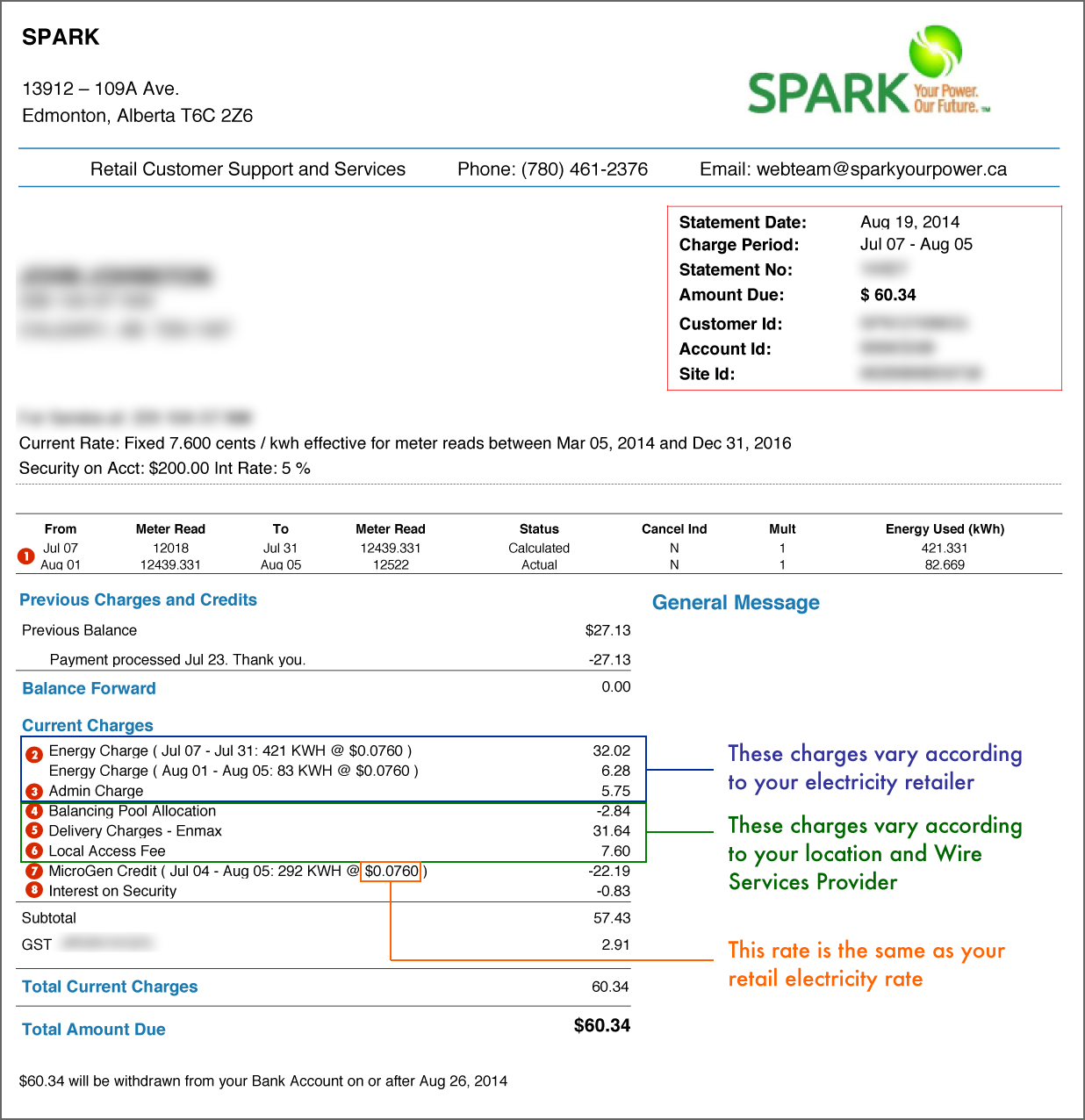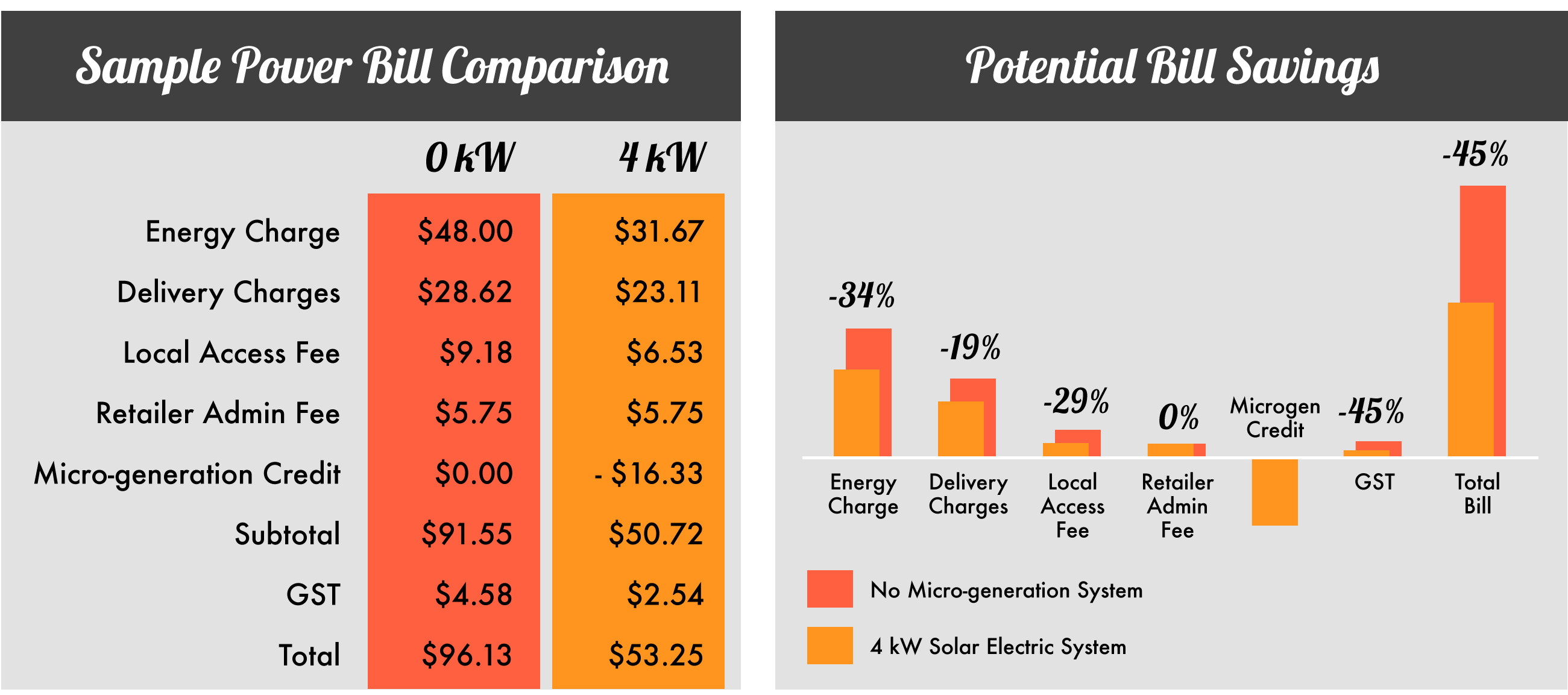The beauty of having a deregulated electricity market here in Alberta is that consumers have access to countless energy providers and a wide array of competitively priced electricity plans to choose from. Plus, if you own a micro-generation system, it’s so easy and seamless to connect to the grid. However, before deciding on an electricity provider and a micro-generation system, you should probably first understand how your electricity bill is calculated. It is important to note that the only portion of your bill which changes when you switch between electricity retailers is the energy charge which is dependent on your electricity rate and the administration fee which is set by each retailer. As a micro-generator, you will automatically receive a micro-generation credit on your monthly bill for excess energy supplied to the grid, regardless of which retailer you have signed on with.
In the info graphic below, we have illustrated a rough breakdown of the average electricity bill in Calgary, with and without a micro-generation system. In both scenarios, you will notice that the two main charges in the electricity bill are the cost of energy consumed and the cost of delivering this energy. However, by installing a 4 kW solar electric system, the energy charge is reduced by 34%, delivering charges are reduced by 19% and the local access fee is reduced by 29%, with an overall 45% reduction in the total bill amount. Your energy charge as well as the variable portion of your delivery charges and local access fee will decrease accordingly when the energy produced by your micro-generation system is consumed within the home/building. Any excess energy from your system that is supplied to the grid, will show up as a micro-generation credit (savings) on your bill.
ASSUMPTIONS
Electricity consumption of the average Alberta residence: 7,200 kWh per year (600 kWh per month)
Micro-generation System: 4 kW Solar Electric System with 4,900 kWh annual output (Half of the microgeneration production is consumed within the home and the other half is supplied back to the grid)
Electricity Rate: 8 cents/kWh
Retailer Administration Fee: $5.75 (SPARK Admin Fee)
Delivery Charges:
Enmax Distribution and Transmission Charges
Service and Facilities Charge: $0.414380 per day (30-day billing cycle)
System Usage Charge: $0.008621 per kWh
Variable Charge: $0.019463 per kWh
Local Access Fee:
City of Calgary Local Access Fee
11.11% of the total revenue from delivery charges in the billing period + 11.11% of the monthly RRO energy charge per kWh of energy delivered (RRO for September: 9 cents/kWh)
Now, here’s the breakdown of an actual power bill:

1) Meter Reading
The distribution company (not always the same as your retailer) reads your meter at least every 60 days, but not necessarily monthly. Your bill will state whether the current charges are based on an estimate of your consumption or an actual meter reading.
2) Energy Charge
This is the cost of electric energy you have used in a billing period. These charges are expressed in cents per kilowatt-hour (¢/kWh). You can choose to buy electricity from a regulated or a competitive retailer. Regulated retailers offer the Regulated Rate Option (RRO) which is calculated based on the projected market price of electricity. Whereas, the competitive retailers offer various products including long term fixed rate plans with no exit fees, as well as green energy rate plans. View your options here.
3) Administration Fee
This fee is charged by your chosen electricity retailer to cover the costs related to billing and customer service. Every retailer has varying administration charges.
4) Balancing Pool Allocation
Under provisions of the Electric Utilities Act, each year the Balancing Pool is required to forecast its revenues and expenses and to determine whether any excess (or shortfall) funds will be allocated to electricity consumers. This amount is known as the Consumer Allocation and applies to all market participants who receive system access service from the Alberta Electric System Operator (AESO) in accordance with Rider F of the ISO Tariffs. The allocation is based on the amount of electric energy consumed annually. Approximately 80% of the annual allocation goes to commercial and industrial electricity consumers, with the remainder to the residential and farm sector.
5) Delivery Charges
The fixed portion of your delivery charge is calculated based on the costs of building and maintaining the local and provincial grids to deliver electricity, regardless of consumption. Whereas, the variable portion of your delivery charge covers the operating cost of the distribution and transmission systems based on the amount of energy consumed. Not only does your delivery charge vary according to your size but it also determined by your location and Wire Services Provider.
View the full list of tariff rates for each distribution company at the links below:
• ATCO Electric
• EPCOR Distribution Inc.
• ENMAX Power Corp.
• FortisAlberta Inc.
• City of Lethbridge
• City of Medicine Hat Electric
• City of Red Deer Electric Light & Power
6) Local Access Fee
This fee is paid to your local government or band council to allow utilities access to land to construct, maintain and operate the distribution system serving the consumers.
7) Micro-generation Credit
Micro-generators in Alberta automatically receive credit which is equivalent to their current electricity rate, for surplus electricity generated and exported to the grid. For instance, if you currently paying 8 cents/kWh for electricity, you will receive 8 cents/kWh for any excess solar energy that is supplied back to the grid from your system. The bidirectional meter which is supplied free of charge by your Wire Services Provider, keeps track of both the energy imported from the grid and the energy exported to the grid.
8) Interest Payment on Security
Some electricity retailers require their customers to make a one-off security payment when they sign up with them. This fully refundable security payment helps cover the bonds that the electricity retailer has to put up with the Alberta Electric Systems Operator (AESO) and Wire Services Providers. One of the benefits of placing a security payment with your retailer, is the interest payment that you’ll receive on your monthly bills.


